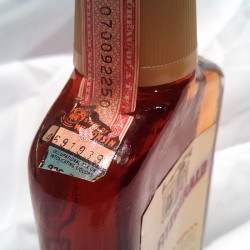What is a tax strip and why is it on the cap of my whiskey?
Tax strips are the bit of paper that were affixed over the cap/cork to indicate that the tax had been paid and the bottle has not been tampered with. Red strips denote federal tax, blue strips are for export, and green strips denote bottled in bond. There is sometimes a state tax paper stamp on the shoulder of the bottle. State tax stamps changed every four years when new state treasurers were appointed.
The use of tax strips over the cap began after the Bottled in Bond Act in 1897. It was a green decorative strip that showed the public that the whiskey within the bottle was 100 proof, bottled by one distiller in one distilling season and was at least 4 years old. (not to mention paid its taxes on its bonded time in warehouses…) In 1934, after Prohibition, the Liquor Taxing Act contained new tax rates and those rates being paid relied largely on the old storekeeper gauger system for administering the tax. Title II of this act added the tax strip system which continued until 1979.
In general, taxes were determined when the whiskey left the bonded premises, although payment may have been deferred for six months if a withdrawal bond had been posted. In 1979, the Trade Agreements Act, aside form creating uniformity in the treatment of domestic and foreign products, eliminated the tax stamp system and began to treat the entire distilled spirits plant as bonded premises. (Taxes were now permitted to be applied to bottles after being shipped.) This elimination of the complex system of bonded and unbonded premises reduced the need for constant IRS supervision and placed the burden on distillers to keep adequate records for IRS inspections. TheTax Reform Act of 1984 would officially eliminate the tax strip from use-These and other changes are contained in sections 451-455 of the Act.98 Stat.818-823. Tax strips would have been used by a company after the law for a short period of time until they came up to code. Often companies may still use a strip of paper over the cap that references the distillery but is not a legal obligation. It is just decorative, though it may show that the bottle has not been tampered with since bottling.
The tax stamp can be useful when trying to date you rbottle of whiskey because the stamp changed a few times between 1934 and 1984.
*1934-1944: Weight/Proof Marks on ends, no “Series” near Eagle’s feet. Upper-left edge reads “US Internal Revenue”
*1945-1972: Words “Series” and “111″/”112″ added near Eagles feet. Upper-left edge reads “US Internal Revenue”
*In January of 1961, the “Series 111″ was changed to “Series 112″ on red strips and the size of the bottle no longer appeared at the end of non-bonded strips (except for mini bottles, which were excluded).
*From 1977-1985 the strips referenced Bureau of ATF.
Prior to 1973, green bonded strips denoted the size of the bottle, for example 4/5 qt, on one end of the strip. From 1973 on this was no longer required. This doesn’t seem to have applied to red strips.
*1973-1976: Volume markings removed from ends of Tax Strip. Upper-left edge reads “US Internal Revenue”
*1977-1983: No Volume markings. No “Series” or “111″/”112″ near Eagle’s feet. Upper-left edge reads “Bureau of ATF”
*In 1982 the words “Tax Paid” and “Distilled Spirits” were removed and replaced with simply “Distilled” and “Spirits” on the bottom of the strips.
*The green Bottled in Bond strips were discontinued starting December 1, 1982.

